The Hunting Country was named for the old Cherokee hunting grounds that originally made up the area. It is known today as an equestrian community but it was only in the 19th century that the surrounding countryside was utilized for equestrian activities. Prior to the 1800's, the area was a remote frontier outpost.
A central part of the history of Hunting Country is the Block House, a pre-Revolutionary War trading post and fort. Now a private residence, The Block House was originally built in the mid-eighteenth-century to mark the contentious border between the Cherokee territory to the west and north, and the farmland of the white settlers to the east and south.
It evolved, first, into a trading post for commercial traffic coming through Howard's Gap with goods bound for Columbia and Charleston. It was used as a military post held by an upstart new nation against British-inspired Cherokee raids. Then, it was a tollhouse on the newly-established border between North and South Carolina before becoming a tavern. More famously, it served as a brothel when, it is said, the gentleman who was then is residence absconded, leaving his wife and daughters to fend for themselves for a livelihood.
In the 19th century, when wealthy South Carolinians from the Low Country sought relief from the heat, Tryon became a destination and second home. Among them, many equestrian enthusiasts who bought up large tracts of land in The Hunting Country for use as horse farms. These new residents of Hunting Country enjoyed horse racing and any available open space was used. In the mid-1800's, they even used the broad, cleared strips of land being laid out for the Spartanburg - Asheville railroad until crews arrived to lay track.
By the middle of the 19th century, these native sons were followed by increasing numbers of Midwesterners, who had begun climbing aboard the new Cincinnati-to-Charleston railroad. They left their harsh, northern winters behind but brought with them their love of horse sport.
Although certainly not the first Midwesterner to come to Tryon, it was Carter P. Brown who, more than any of his peers, would transform the rural landscape around a small southern town into an attractive alternative for mobile Northerners. Brown was considered “the man who put Tryon on the map as a horse center”.
When Carter Brown stepped off the train from Michigan in 1917, he wasn't particularly thinking about an equestrian mecca, even though he was an avid horseman and outdoor sports enthusiast. He was, rather, thinking about opening a business. He converted a tubercular sanatorium in Tryon into the Pine Crest Inn, still operating today as a AAA Four-Diamond award winning inn. Brown then invited fellow sportsmen to come to the area, stay at The Pine Crest, and enjoy the warm climate and equestrian pursuits.
Over time, he built a number of equestrian farms in The Hunting Country for his guests - each home unique. These families that moved to The Hunting Country helped form the modern equestrian community that thrives today in The Hunting Country and also helped make preservation of our natural resources, along with developing a comprehensive trail system (FETA), a priority.
Carter Brown went on to have a major influence on the development of Tryon and The Hunting Country. He founded the Tryon Riding and Hunt Club in 1925, organized the Tryon Hounds in 1926, established the Tryon Horse Show in 1929. He went on to establish The Blockhouse Steeplechase in 1947 on a 1/2 mile course around The Block House residence. In 1985, the Foothills Equestrian Nature Center (F.E.N.C.E.) was established in The Hunting Country. On 384 acres, F.E.N.C.E serves as a recreational, nature and equestrian park.
Today, through the efforts of the residents and the Hunting Country! organization, the Hunting Country maintains its rural character and natural beauty. The goal of Hunting Country! Association is to maintain the special place where we live for generations to come.
* Excerpted from Tryon Style, Horses and Humans in the Foothills Community by Libbie Johnson and Norman Powers.
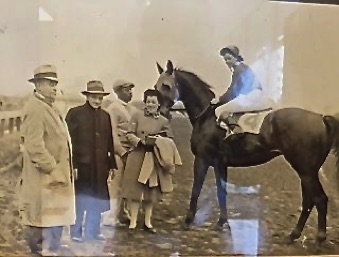
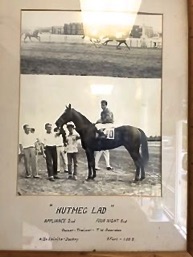
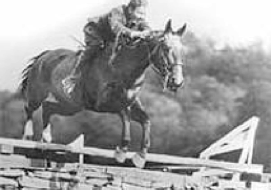
“Double B” Jockey June Deardon, Owner Mrs. A. Wesley and JHastie Trainer “All Girls Jockeys Race” Rockingham Park - November 11, 1943 Pictured at right: June Deardon on Nutmeg Lad.
HUNTING COUNTRY
HISTORY
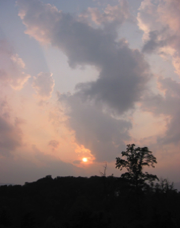
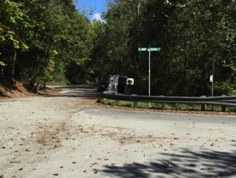
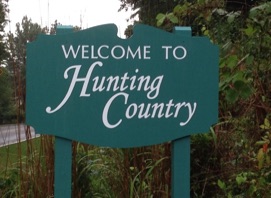
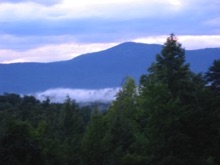
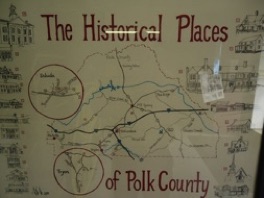
History of The Hunting Country! Association by Burt Baer
The Hunting Country Assn. as we know it today got its start back in 1984 by organizers Mary Lenox and Hughes Zweig. They and others foresaw future high density growth looming and wanted to
introduce zoning as a means of preserving the character of our area. At the time zoning had not
been successfully introduced anywhere in Polk County.
A formal meeting of residents living in the Old Hunting Country was held at the Tryon Methodist Church on New Market Rd. on April 12, 1984. Residents in attendance were asked to approve the proposed Articles of Incorporation and By-laws. A nominating committee of Anne Villican and Virginia Dreyer proposed the following to serve as our first Board of Directors. They were Charles Didier, George Villican, Hughes Zweig, Virginia Dreyer, John Lenox, Robert Vucha, Henry Burrus, Robert Kramer Jr., and Bruce Palmer. They were all elected.
Shortly thereafter the residents of Many Levels including Hughes Zweig, Jack Carr, and Carl Schumacher got together and went door to door to solicit support for 2 acre minimum lot size zoning in the Hunting Country area. Support was 100 percent in favor of going to the County Commissioners with a formal request for such zoning. State guide-lines were researched and followed. There was much antagonism shown by the County Commissioners at the time, but in view of the strong support from landowners, they approved the request and the RE-2 district was formed. The town of Tryon also approved our 2 acre zoning in their R-1 district.
After a time concerns were raised about land bordering FENCE being un-zoned. Al Haskel was on the Board at the time and later became President. He got together with Carl Wharton, then on the County Planning Board, to extend the size of Hunting Country from Morgan Chapel Rd. to Red Fox on its eastern boundary and from River Road through most of Golden Road on the northern boundary. With a recommendation from the Planning Board, the Commissioners approved that expansion sometime in the mid 90's.
Burt Baer was appointed by Board President Wayne Inks in 1999 to research the possibility of growing our 2 acre zoning to 5 acres. Residents were polled and the majority indicated their approval for the change. At the Annual Meeting of the Hunting Country Property Owner's Association on October 15, 1999, the decision was made to go forward with 66 voting in favor, none against, and one abstaining. Newly elected Board member Jim McDermott joined with Burt, working with Ruth Grubbs and in the Spring of 2000 5 acre zoning was approved in the Tryon R-1 district and later in the RE-2 County district which became known as County RE-5.
Over the years the Hunting Country Assn. has mounted successful defenses against the inappropriate use of land in our area. We remain dedicated to preserving our equestrian character, preserving our private trail system maintained by FETA, promoting orderly growth, protecting our area from overdevelopment, protecting environmentally and culturally significant areas, and working to prevent visual eyesores from appearing in the Hunting Country.
Our thanks to all those on previous Hunting Country Boards who have made the improvements to Hunting Country possible!